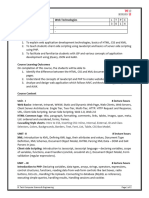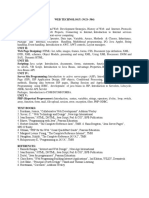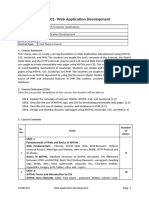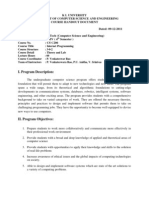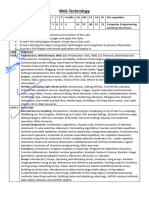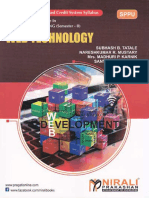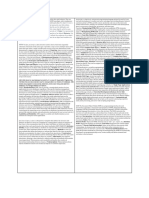Web Programming
Uploaded by
ManojWeb Programming
Uploaded by
ManojGovernment of Karnataka
Department of Technical Education
Bengaluru
Course Title: Web Programming
Course Code:
Scheme (L:T:P) : 4:0:0 Total Contact Hours: 52
15CS52T
Type of Course: Lectures, Self Core/ Elective:
Credit :04
Study & Student Activity. Core
CIE- 25 Marks SEE- 100 Marks
Prerequisites:
Knowledge of HTML and CSS.
Course Objectives
To study the concepts of web application development such as XHTML, XML, PHP, Java
web software, and Database access through JDBC and PHP.
Course Outcome
On successful completion of the course, the students will be able to attain below Course
Outcome (CO):
CL Linked PO Teaching
Course outcome
Hours
CO1 Discuss the fundamentals of web and concept 06
of XHTML. R,U,A 1,2,3,6,7,8,9,10
CO2
Describe different concepts of JavaScript and 12
XHTML documents and Construct dynamic U,A 1,2,3,6,7,8,9,10
documents with JavaScript.
CO3
Describe XML using the user defined tags, 08
DTD, Namespaces and Schemas with simple R,U,A 1,2,3,6,7,8,9,10
programs.
CO4 Discuss the concepts of PHP with associated 10
R,U,A 1,2,3,6,7,8,9,10
programs
CO5 Discuss different ways to access the database 06
U,A 1,2,3,6,7,8,9,10
through the web using examples.
CO6 Discuss various server based software using 10
U,A 1,2,3,6,7,8,9,10
different technologies.
Total 52
Legends: R = Remember U= Understand; A= Apply and above levels (Bloom‘s revised
taxonomy)
Course-PO Attainment Matrix
Course Programme Outcomes
1 2 3 4 5 6 7 8 9 10
Web Programming 3 3 3 - - 3 3 3 3 3
Directorate of Technical Education Karnataka State CS&E 15CS52T
Level 3- Highly Addressed, Level 2-Moderately Addressed, Level 1-Low Addressed.
Method is to relate the level of PO with the number of hours devoted to the COs which address the given PO.
If >40% of classroom sessions addressing a particular PO, it is considered that PO is addressed at Level 3
If 25 to 40% of classroom sessions addressing a particular PO, it is considered that PO is addressed at Level 2
If 5 to 25% of classroom sessions addressing a particular PO, it is considered that PO is addressed at Level 1
If < 5% of classroom sessions addressing a particular PO, it is considered that PO is considered not-addressed.
Course Content and Blue Print of Marks for SEE
Unit Hour Questions to be Marks Marks
No Unit Name set for Weightage Weightage
SEE (%)
R U A A
I Fundamentals and 06 05 05 05 15 10.35
Introduction to
XHTML
II Java Script and 12 - 20 15 35 24.13
XHTML Documents
and Dynamic
documents with
JavaScript
III Introduction to XML 08 05 10 05 20 13.79
IV Introduction to PHP 10 05 15 10 30 20.69
V Database Access 06 - 05 10 15 10.35
through Web
VI Java Web Software 10 - 15 15 30 20.69
Total 52 15 70 60 145 100
UNIT I : Fundamentals and Introduction to XHTML 06 Hrs
Fundamentals – A brief introduction to Internet, Origins, What the Internet Is, Internet
Protocol Addresses, Domain Names, The World Wide Web, Origins, Web or Internet, Web
browsers, Web servers, Web Server Operations, General Server Characteristics, Apache, IIS,
Uniform Resource Locators, URL Formats, URL Paths, Multipurpose Internet Mail
Extensions, Type Specification, Experimental Documental Types, Hypertext Transfer
Protocol, The Request Phase, The Response Phase, Security, The web Programmers Toolbox
Introduction to XHTML: Syntactic differences between HTML and XHTML
UNIT II: JavaScript and XHTML documents and Dynamic documents with JavaScript
12 Hrs
JavaScript and XHTML documents – The JavaScript Execution Environment, The
Document Object Model, Element Access in JavaScript, Events & Event Handling, Basic
Concepts of Event handling, Events, Attributes & Tags, Handling Events from Body
Elements, Handling Events from Button Elements, Handling Events from Textbox &
password Elements, The Focus Event, Validating from Input, The DOM2 Event Model,
Event Propagation, Event handler registration, An Example of the DOM2 Event Model, The
Navigator Object, DOM Tree Traversal and Modification, DOM Tree Traversal, DOM Tree
Modification.
2
Directorate of Technical Education Karnataka State CS&E 15CS52T
Dynamic documents with JavaScript: Introduction, Positioning Elements, Absolute
Positioning, Relative Positioning, Static Positioning, Moving Elements, Element Visibility,
Changing Colors & Fonts, Changing Colors, Changing Fonts, Dynamic Contents, Stacking
Elements, Locating the Mouse Cursor, Reacting to the Mouse Click, Slow Movement of
Elements, Dragging & Dropping Elements.
UNIT III: Introduction to XML 08 Hrs
Introduction, The Syntax of XML, XML Document Structure, Document Type Definitions,
Declaring Elements, Declaring Attributes, Declaring Entities, A Sample DTD, Internal &
External DTDs, Namespaces, XML Schema, Schemas Fundamentals, Defining the Schema,
Defining the Schema Instances, An Overview of Data types, Simple Types, Complex Types,
Displaying Raw XML Documents, Displaying XML Documents with CSS.
UNIT IV: Introduction to PHP 10 Hrs
Introduction to PHP: Origins and Uses of PHP, Overview of PHP, General Syntactic
Characteristics, Primitives, Operations and Expressions, Variables, Integer Type, Double
Type, String Type, Boolean Type, Arithmetic Operations & Expressions, String Operations,
Scalar Type conversions, Output, Control statements, Relational Operators, Boolean
Operators, Selection Statements, Loop statements, An Example, Arrays, Array Creation,
Accessing array Elements, Functions for Dealing with Arrays, Sequential Access to Array
Elements, Sorting Arrays, Functions, General Characteristics of Functions, Parameters, The
scope of Variables, The Lifetime of Variables, Pattern Matching, Form Handling, Files,
Opening and Closing Files, Reading from a File, Writing to a File, Locking Files, Cookies,
Introduction to Cookies, PHP Support for Cookies, Session Tracking.
UNIT V: Database access through the Web 06 Hrs
Database Access with PHP & MySQL, Potential Problems with Special Characters,
Connecting to MySQL & Selecting the Database, Requesting MySQL Operations, A PHP/
MySQL Examples, Database Access with JDBC & MySQL, JDBC & MySQL, Metadata,
Examples.
UNIT V: Java Web Software 10 Hrs
Introduction to Servlets, Overview, Details, Servlet Containers, The NetBeans IDE, Storing
information on Clients, Cookies, Servlet support for Cookies, Examples, JavaServer
Pages(JSP), Motivation for JSP, JSP Documents, The Expression Language, The JSTL
control action elements, JavaBeans, Model-View-Controller Application Architecture,
JavaServer Faces, The tag libraries, JSF event handling, An example application.
Text books
1. Programming the World Wide Web, 7th edition, Robert W.Sebesta , Pearson
Education, ISBN- 9789332518827
References
1. http://www.tutorialspoint.com/
2. http://www.w3schools.com/
3. Web Programming – Building Internet Applications, 3rd edition, Chris Bates, Wiley
publisher
3
Directorate of Technical Education Karnataka State CS&E 15CS52T
4. Web Technologies— HTML,JavaScript,PHP,java,JSP,ASP.Net,XML & Ajax –
Black Book, Wiley, ISBN : 978-81-7722-997-4
5. PHP A Begineer‘s Guide --- Vikram Vaswami , TMH publishers. ISBN: 13:978-0-
07-014069-1
Suggested list of student activities
Note: the following activities or similar activities for assessing CIE (IA) for 5 marks (Any
one)
Student activity like mini-project, surveys, quizzes, etc. should be done in group of 3-5
students.
1. Each student should do any one of the following type activity or any other similar
activity related to the course and before conduction, get it approved from concerned course
coordinator and programme coordinator.
2. Each student should conduct different activity and no repeating should occur
1 Prepare a simple website using NetBeans IDE.
2 Demonstration of PHP program which includes database access.
3 Create a simple webpage using JSON.
4 Quiz
Course Delivery
The course will be delivered through lectures and Power point presentations/ Video
Course Assessment and Evaluation Scheme
Method What To When/Where Max Evidence Course
who (Frequency in Marks collected outcomes
m the course)
CIE IA Three IA tests 1 to 6
(Average of
Direct Assessment
20 Blue books
three tests will
Students
be computed)
Student 1 to 6
05 Report
activities
Total 25
SEE End End of the Answer scripts 1 to 6
100
Exam course at BTE
Course Survey Middle of the 1, 2, 3 Delivery
Indirect Assessment
Feedback forms
course of course
End of the 1 to 6
Students
course Effectiveness of
Delivery of
Questionnaires
instructions &
Assessment
Methods
Note: I.A. test shall be conducted for 20 marks. Average marks of three tests shall be rounded off
to the next higher digit.
Directorate of Technical Education Karnataka State CS&E 15CS52T
Questions for CIE and SEE will be designed to evaluate the various educational
components (Bloom’s taxonomy) such as:
Sl. No Bloom’s Category %
1 Remembrance 10
Weightage
2 Understanding 50
Weightage
3 Application 40
Note to IA verifier: The following documents to be verified by CIE verifier at the end of
semester
1. Blue books (20 marks)
2. Student suggested activities report for 5 marks
3. Student feedback on course regarding Effectiveness of Delivery of instructions &
Assessment Methods.
FORMAT OF I A TEST QUESTION PAPER (CIE)
Test/Date and Time Semester/year Course/Course Code Max Marks
Ex: I test/6 th week of V SEM
20
sem 10-11 AM
Year:
Name of Course coordinator : Units:__
CO‘s:____
Question
Question MARKS CL CO PO
no
1
2
3
4
Note: Internal choice may be given in each CO at the same cognitive level (CL).
MODEL QUESTION PAPER (CIE)
Test/Date and
Semester/year Course/Course Code Max Marks
Time
Ex: I test/6 th week V SEM Web Programming
20
of sem 10-11 AM Year: 2017-18 Course code: 15CS52T
Name of Course coordinator :
Units:1,2 COs: 1,2
Note: Answer all questions
Question
Question CL CO PO
no
1 Explain the operation of web server. (5) U 1 1,2,3,6,7,8,9,10
OR
Explain MIME with its type specification. (5)
2 Explain how to handle the focus event with an example (5) A 2 1,2,3,6,7,8,9,10
OR
Illustrate Moving elements with simple example. (5)
3 Illustrate the HTTP protocol‘s request and response phases A 1 1,2,3,6,7,8,9,10
with an example for each. (10)
.
5
Directorate of Technical Education Karnataka State CS&E 15CS52T
Format for Student Activity Assessment
DIMENSION Unsatisfactory Developing Satisfactory Good Exemplary Score
1 2 3 4 5
Collection of Does not Collects Collects Collects Collects a 3
data collect any very limited some basic relevant great deal of
information information; information; information;information;
relating to the some relate refer to the concerned all refer to
topic to the topic topic to the topicthe topic
Fulfill team’s Does not Performs Performs Performs allPerforms all 4
roles & duties perform any very little nearly all duties duties of
duties assigned duties duties assigned
to the team team roles
role with
presentation
Shares work Always relies Rarely does Usually Does the Always 3
equally on others to do the assigned does the assigned job does the
the work work; often assigned without assigned
needs work; rarely having to be work
reminding needs reminded. without
reminding having to be
reminded
and on
given time
frame
Listen to Is always Usually Listens, but Listens and Listens and 3
other Team talking; never does most sometimes contributes contributes
mates allows anyone of the talk too to the precisely to
else to speak talking; much relevant the relevant
rarely topic topic and
allows exhibit
others to leadership
speak qualities
TOTAL 13/4=3.25=4
Note: This is only an example. Appropriate rubrics/criteria may be devised by the concerned
course co-ordinator for assessing the given activity.
Directorate of Technical Education Karnataka State CS&E 15CS52T
MODEL QUESTION PAPER Code: 15CS52T
Diploma in Computer Science & Engineering
V- Semester
Course Title: Web Programming
Time: 3 Hours Max Marks: 100
PART-A
Answer any SIX questions. Each carries 5 marks. 5X6=30 Marks
1. Define Web Browser, Web Server, Event, Event Handling and Internet.
2. Describe the parameters and actions of the setTimeout and setInterval functions.
3. Define DTD. Mention four possible keywords in DTD declaration.
4. Explain four scalar types of PHP.
5. Explain built-in sting manipulation functions.
6. Explain potential problems associated with special characters.
7. Construct a PHP script to insert records through form into a database.
8. Write a note on JavaBeans.
9. Explain JSF event handling.
PART-B
Answer any SEVEN full questions each carries 10 marks. 10X7=70 Marks
1. Illustrate the HTTP protocol‘s request and response phases with an example for each.
2. Illustrate with an example for dynamic stacking of images
3. Explain declaring of elements, attributes and entities in DTD with an example.
4. Explain different XSD indicators.
5. Explain how to create indexed and associated array with an example.
6. Write a PHP script to illustrate sort, assort and ksort functions.
7. Write a PHP script to insert record into the table and retrieve records from the tabl.
Assume a table ―my_detail‖ is already created with fields name, city, phone_no and
mail_id.
8. Explain the steps involved in accessing mySQL database through JDBC.
9. Explain life cycle of a Servlet.
10. Explain steps in JDBC.
Directorate of Technical Education Karnataka State CS&E 15CS52T
MODEL QUESTION BANK
Diploma in Computer Science & Engineering
V Semester
Course Title: Web Programming
CO Question CL Marks
Define Web Browser, Web Server, Event, Event Handling and Internet R
Explain domain names with an example. U
Explain the operation of web server. U
Illustrate the general server characteristics. U
Explain the file structure of web server. U
Define MIME, Web security, URL R 05
Discuss URL format with its different paths. U
I Explain MIME with its type specification U
Illustrate the HTTP protocol‘s request and response phases U
Discuss web security issues. U
Mention the differences between html and xhtml. U
Explain the HTTP protocol‘s request and response phases with an A
example for each. 10
Explain the operation of Web Server with its file structure. U
Explain the structure of DOM. U
List DOM node properties U
Describe the parameters and actions of the setTimeout and setInterval U 05
functions.
Illustrate Moving elements with simple example. A
Explain Element visibility with simple example A
II Explain how to locate the mouse cursor. U
Explain different types of positioning with an example U
Illustrate with an example for dynamic stacking of images A
Explain with an example how to change dynamically background and A
foreground Colors of the document. 10
Illustrate moving elements and element visibility with an example. A
Discuss the two ways to register an event handler in DOM-0 event A
model.
Explain the 3 phases of event processing in the DOM-2 event model A
Illustrate how to handle blur event and change event with an example A
Explain how to handle the focus event with an example A
Write a note on XML. U
List the features of XML U
Write a note on XML document structure. U
Define DTD. Mention four possible keywords in DTD declaration. R
Define XML schema. List the advantage of XML schema over DTD. R
Differentiate between simple type and complex type XML elements. U 05
Explain Internal and External DTD‘s with an example. U
8
Directorate of Technical Education Karnataka State CS&E 15CS52T
III Illustrate declaring of elements, attributes and entities in DTD with an A
example.
Explain different XSD indicators. A
Explain how to declare namespace with example. A 10
Explain schema and schema instance with an example. A
Explain how to create simple type and complex type element with an A
example.
Write a note on PHP. U
Explain four scalar types of PHP. U
Explain built-in sting manipulation functions. U
Explain Implicit and Explicit type conversions. U
Write PHP script to compute the sum of positive integers upto 30 using A
do-while statement.
Write PHP script to compute factorial of ‗n‘ using while or for loop U
construct.
Explain the syntax of for-each statement with an example. A
IV 5
Write a PHP script to sort an array of elements. A
Explain how cookies are extracted using PHP. U
Write a note on session tracking. U
Explain preg_match() and preg_split() functions with example. U
Construct a PHP script to compute the squareRoot, Square, Cube and A
Quad of 10 numbers.
Explain how to create indexed and associated array with an example. U
Write a PHP script to illustrate sort, assort and ksort functions. A 10
Write a note on PHP and its scalar types. U
Explain types of arrays with an example in PHP. A
Explain potential problems associated with special characters. U
Write PHP functions used to connect to MYSQL database and selecting U
a database
Construct a PHP script to insert records through form into a database. A 05
V Construct a PHP script to retrieve records from the database table. A
Discuss how the collection of metadata extracted from a database. U
Explain the use of mysql_query() method used to execute SQL queries U
with its syntax.
Write a PHP script to create a table, insert records into the table, retrieve A
records from the table. Assume database ―Student‖ and table 10
―cs_student‖ with fields name, sem, regno, address
Write a PHP script to insert record into the table and retrieve records A
from the tabl. Assume a table ―my_detail‖ is already created with fields
name, city, phone_no and mail_id
Construct a PHP script to insert and retrieve records from the database A
table.
Illustrate the use of: U
Mysql_query(), mysql_connect(), mysql_select_db(),
mysql_num_rows() and mysql_num_fields()
Explain the steps involved in accessing mySQL database through JDBC. U
Write a note on Servlet Containers. U
9
Directorate of Technical Education Karnataka State CS&E 15CS52T
Explain doGet and doPost methods of the HttpServlet class. U
Write a note on Cookies. U
List the five parts of JSTL. U 05
Explain three elements associated with JSP. U
Write a note on MVC application Architecture. U
Explain the two standard tag libraries of JSF. U
VI Explain the different methods of Cookies with an example. A
Explain the processing flow of JSP documents with a neat diagram. U
Illustrate JSTL control action elements with an example for each. A 10
10
Directorate of Technical Education Karnataka State CS&E 15CS52T
You might also like
- Build A Frontend Web Framework (From Scratch) (Ángel Sola Orbaiceta) (Z-Library)100% (1)Build A Frontend Web Framework (From Scratch) (Ángel Sola Orbaiceta) (Z-Library)386 pages
- 15IT304J Web Programming L T P C 3 0 2 4No ratings yet15IT304J Web Programming L T P C 3 0 2 43 pages
- Co-Requisite: Prerequisite: Data Book / Codes/Standards Course Category Course Designed by ApprovalNo ratings yetCo-Requisite: Prerequisite: Data Book / Codes/Standards Course Category Course Designed by Approval3 pages
- Format For Course Curriculum: L T P/ S SW/F W Total Credit Units PsdaNo ratings yetFormat For Course Curriculum: L T P/ S SW/F W Total Credit Units Psda6 pages
- Cse4001 Internet-And-web-programming LTP 1.0 1 Cse4001No ratings yetCse4001 Internet-And-web-programming LTP 1.0 1 Cse40013 pages
- 18cs63 Web Technology and Its Applications SyllabusNo ratings yet18cs63 Web Technology and Its Applications Syllabus3 pages
- Cse3002 Internet-And-Web-Programming Eth 1.1 47 Cse3002No ratings yetCse3002 Internet-And-Web-Programming Eth 1.1 47 Cse30022 pages
- Course Outcome Experiment Linked CL: Department of Technical EducationNo ratings yetCourse Outcome Experiment Linked CL: Department of Technical Education8 pages
- Cse326 Internet-And-web-programming Eth 1.00 Ac26No ratings yetCse326 Internet-And-web-programming Eth 1.00 Ac263 pages
- TY BCA (Sci) Sem V Syllabus - 06.062018No ratings yetTY BCA (Sci) Sem V Syllabus - 06.06201824 pages
- Computer Engineering Syllabus Sem V Mumbai UniversityNo ratings yetComputer Engineering Syllabus Sem V Mumbai University7 pages
- BCA_3rd_Sem_TBC301_Web Application Development_Sunita Ratnoji-V1No ratings yetBCA_3rd_Sem_TBC301_Web Application Development_Sunita Ratnoji-V12 pages
- Scheme and Syllabus: Academic Year 2020-2021 CSE - Computer Science & EngineeringNo ratings yetScheme and Syllabus: Academic Year 2020-2021 CSE - Computer Science & Engineering35 pages
- Lesson Plan: LP-IT2353 LP Rev. No: 00 Date: 15-12-10 Page: 01 of 06No ratings yetLesson Plan: LP-IT2353 LP Rev. No: 00 Date: 15-12-10 Page: 01 of 067 pages
- 02.WPSpring2024CourseLog (CLT) - EngrAbdulRahman - V4-DistNo ratings yet02.WPSpring2024CourseLog (CLT) - EngrAbdulRahman - V4-Dist2 pages
- Gujarat Technological University: Page 1 of 3No ratings yetGujarat Technological University: Page 1 of 33 pages
- CS6501 SCAD MSM by WWW - Learnengineering.inNo ratings yetCS6501 SCAD MSM by WWW - Learnengineering.in213 pages
- Syllabus Web Programming: Subject Code Name of Subject Credit Hours Credit Hours PrerequisiteNo ratings yetSyllabus Web Programming: Subject Code Name of Subject Credit Hours Credit Hours Prerequisite4 pages
- C# Fundamentals Made Simple: A Practical Guide with ExamplesFrom EverandC# Fundamentals Made Simple: A Practical Guide with ExamplesNo ratings yet
- Birla Institute of Technology & Science, Pilani: Work Integrated Learning ProgrammesNo ratings yetBirla Institute of Technology & Science, Pilani: Work Integrated Learning Programmes289 pages
- React Interview Questions and Answers by ScholarHatNo ratings yetReact Interview Questions and Answers by ScholarHat10 pages
- Topic 9: Understanding The Functions of JavascriptNo ratings yetTopic 9: Understanding The Functions of Javascript9 pages
- Buy ebook Introducing JavaScript Game Development Build a 2D Game from the Ground Up 1st Edition Graeme Stuart cheap price100% (3)Buy ebook Introducing JavaScript Game Development Build a 2D Game from the Ground Up 1st Edition Graeme Stuart cheap price55 pages
- Part 1: HTML and CSS: IN5320 - Development in Platform Ecosystems Individual Practical Assignment 1No ratings yetPart 1: HTML and CSS: IN5320 - Development in Platform Ecosystems Individual Practical Assignment 16 pages

